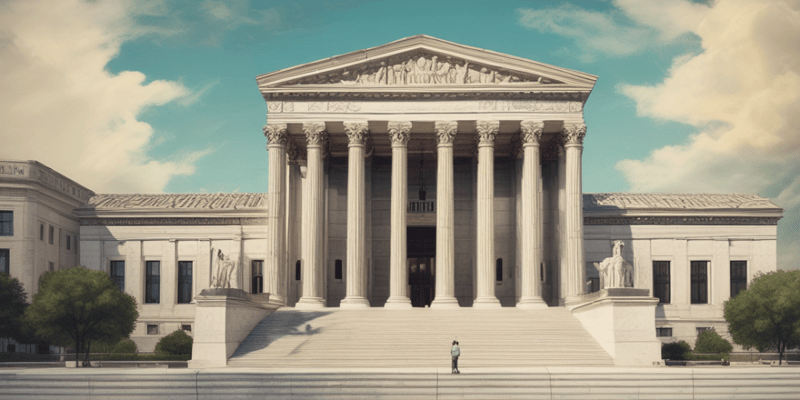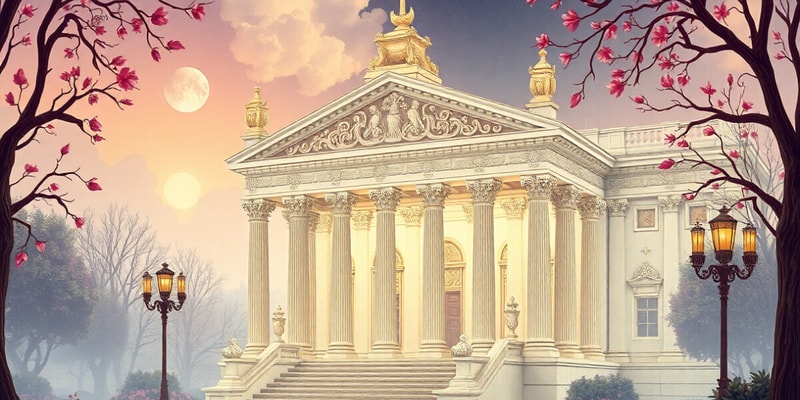Podcast Beta
Questions and Answers
Which case established the principle of judicial review?
Who defined judicial review as the 'very essence of judicial duty'?
In what situation can judicial review be applied?
What happens when the courts find an action to be unconstitutional?
Signup and view all the answers
Which type of cases are typically heard in federal courts?
Signup and view all the answers
What can result in a case being heard in both state and federal courts?
Signup and view all the answers
What is a defining characteristic of the federal court structure?
Signup and view all the answers
What common misconception do people have about Supreme Court justices after they are appointed?
Signup and view all the answers
Which justice was notably described as the Court's swing vote during their tenure?
Signup and view all the answers
How has the composition of the federal judiciary changed over the years?
Signup and view all the answers
Which controversial nominee did President Reagan appoint that is commonly remembered today?
Signup and view all the answers
What is the term used to describe the Supreme Court of the United States?
Signup and view all the answers
During which presidency was there discussion about expanding the Supreme Court?
Signup and view all the answers
What is one reason federal judges are appointed for life?
Signup and view all the answers
What does the phrase 'advice and consent' refer to in the context of judicial nominations?
Signup and view all the answers
What major impact does the ideological stance of a president have on judicial appointments?
Signup and view all the answers
Which of the following statements about the judicial system's flexibility is true?
Signup and view all the answers
When does the Supreme Court begin its annual session?
Signup and view all the answers
What role does the solicitor general play in an amicus brief?
Signup and view all the answers
What typically happens after briefs are filed before the Supreme Court hears a case?
Signup and view all the answers
How is the docket related to the Supreme Court?
Signup and view all the answers
What happens during oral arguments in the Supreme Court?
Signup and view all the answers
How do the justices decide cases after oral arguments?
Signup and view all the answers
What significant characteristic differentiates public sessions from private conferences of the Supreme Court?
Signup and view all the answers
When are the Supreme Court's opinions typically announced?
Signup and view all the answers
Study Notes
Judicial Review
- Established in 1803 through the landmark case Marbury v. Madison.
- The power of courts to review actions of other branches of government and state governments for constitutionality.
- If actions are deemed unconstitutional, they are nullified.
Structure of the U.S. Judicial System
- Dual System: Federal and State Courts
- Federal Court System: Three-Tiered Structure
- District Courts (Trial Courts): Handle federal cases, witness testimony, and evidence.
- Circuit Courts (Appellate Courts): Review district court rulings.
- Supreme Court: The highest court, with nine justices, final authority on legal issues.
- State Courts: Handle most legal matters, including criminal and civil cases.
Federal Court Jurisdiction
- Cases involving federal law, U.S. Constitution, and disputes between states.
- Interstate commerce, cases where the U.S. is a party, diversity of citizenship cases (over $75,000 in damages).
Stare Decisis
- The principle of following precedent (previous rulings) in legal decisions.
- Provides consistency and stability in legal interpretations and judicial decisions.
Judicial Selection
- Federal Judges: Appointed by the President, confirmed by the Senate.
- Lifetime appointments.
- State Judges: Elected or appointed, depending on the state.
Judicial Diversity
- The U.S. judicial system has become more diverse in recent decades, with increasing representation of women and minorities.
U.S. Supreme Court
- The highest court in the land, with nine justices.
- Decisions bind all other courts in the country.
- Established rules and procedures for case selection and hearing.
- Decisions have a lasting impact on legal and constitutional interpretation.
Supreme Court Session
- The Supreme Court session begins on the first Monday in October and ends in late June.
- The justices select a small number of cases to be placed on the docket for review, typically less than 2% of the thousands submitted.
Case Names
- Cases are presented as petitioner versus respondent, for example, Roe v. Wade.
- The petitioner is the party bringing the appeal and is unhappy with the lower court's decision.
Certiorari
- Most often, the petitioner asks for a writ of certiorari, requesting the lower court send its case records for review.
- Four of the nine justices must vote to grant a writ of certiorari, known as the Rule of Four.
Briefs
- Once a case is placed on the docket, both parties submit briefs outlining their arguments.
- Non-parties with an interest in the case can submit amicus curiae ("friend of the court") briefs.
Oral Arguments
- Oral arguments are held from October to April.
- Each side has 30 minutes for their legal argument, with the justices often interrupting with questions.
- The United States, if not party to a case, may submit an amicus brief.
Court Proceedings
- The courtroom proceedings are formal and involve a ceremonial entrance with a traditional chant by the Court's marshal.
Decisions
- Justices reach decisions privately in conference meetings.
- The Chief Justice speaks first, followed by justices in descending order of seniority.
- An initial vote is taken in private before decisions are made public.
Public Access
- Oral arguments are open to the public, but cameras are not allowed in the courtroom.
- Despite calls for greater transparency, the justices have resisted the pressure.
Court Opinions
- Court decisions are released throughout the term.
- The majority opinion represents the decision of a majority of justices.
- A tied vote occurs rarely and, if it does, the lower court's decision stands.
- Justices in the minority can write dissenting opinions.
- Justices who agree with the outcome but disagree with the reasoning can write concurring opinions.
- Opinions are announced publicly before the Court adjourns for the summer.
Studying That Suits You
Use AI to generate personalized quizzes and flashcards to suit your learning preferences.
Description
pages: 450, 456, 459-464, 466, 468-469




